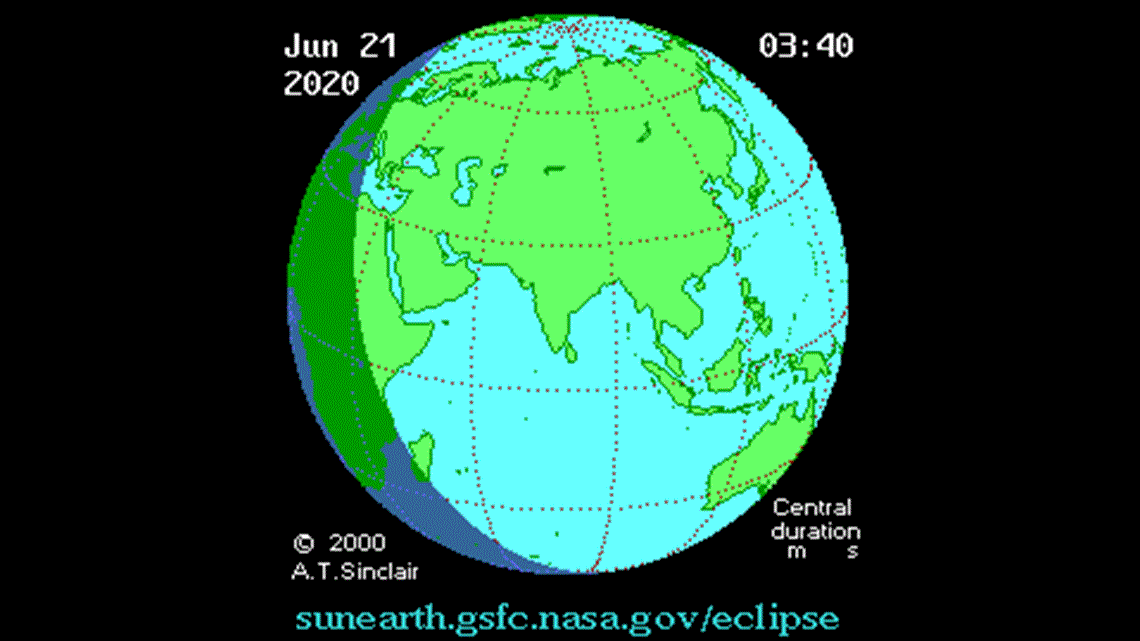Just hours after the official start of summer, the moon will pass directly between the Earth and the sun in a celestial alignment known as a ‘ring of fire' solar eclipse.
This weekend's eclipse will begin about six hours after the June solstice, which occurs on Saturday, June 20, at 5:43 p.m. EDT (Sunday, June 21, 3:13 a.m. IST). Only people across Africa and Asia will be able to witness it with their own eyes, but people from all around the globe can watch the event live in the broadcast below, which will be hosted by Slooh.
During Sunday's eclipse, the moon will be near aphelion, the point in its orbit when it is farthest away from the Earth, creating an annular solar eclipse.
"In an annular solar eclipse, the Moon is too far from the Earth to block out the entire Sun, leaving the Sun peeking out over the Moon's disk in a ring of fire," NASA explained.
This ring of light around the moon during the height of the eclipse is how it became known as a ‘ring of fire' eclipse.
During Sunday's eclipse, the moon will be near aphelion, the point in its orbit when it is farthest away from the Earth, creating an annular solar eclipse.
"In an annular solar eclipse, the Moon is too far from the Earth to block out the entire Sun, leaving the Sun peeking out over the Moon's disk in a ring of fire," NASA explained.
This ring of light around the moon during the height of the eclipse is how it became known as a ‘ring of fire' eclipse.
It is extremely important to use proper eye protection throughout the entire eclipse as the moon will never completely block out all of the light from the sun.
Not using proper solar filters or eclipse glasses can result in permanent eye damage.
"Ordinary sunglasses, even very dark ones, are not safe for looking at the Sun; they transmit thousands of times too much sunlight," the American Astronomical Society (AAS) said on its solar eclipse safety website.
"Do not look at the Sun through a camera, telescope, binoculars, or any other optical device while using your eclipse glasses or handheld solar viewer - the concentrated solar rays could damage the filter and enter your eye(s), causing serious injury," the AAS added.
A partial solar eclipse will be visible across much of Africa, the Middle East and Asia, but the timing depends on where the onlooker is located.
For those in Africa and the Middle East, the eclipse will be visible in the morning. Spectators across India, Nepal and Pakistan can look to the sky around midday to see the eclipse. People across much of China should watch for the eclipse during the afternoon.
To see the ‘ring of fire' around the moon, people need to be perfectly placed in a narrow corridor directly in the center of the moon's shadow. This includes locations southeast of Sana'a, Yemen; southeast of Mascat, Oman; north of New Delhi, India; Xiamen, China; and just southwest of Guam.
For a detailed map showing specific timing and the areas in the path of the annular solar eclipse, visit NASA's interactive eclipse page.


Prospective onlookers will need to keep a close eye on the weather as a few poorly-timed clouds could cause significant disruptions.
Those across Asia and Africa can monitor the cloud conditions in their region by using AccuWeather's interactive weather satellite.
As breathtaking as this weekend's eclipse may be for those in its path, it will be nothing like the second eclipse of 2020. On Dec. 14, the moon will once again pass directly between the Earth and the sun, but this time, it will create a total solar eclipse.
This will be the first total solar eclipse anywhere in the world since July, 2, 2019, and just like its predecessor, it will be best viewed from South America.



